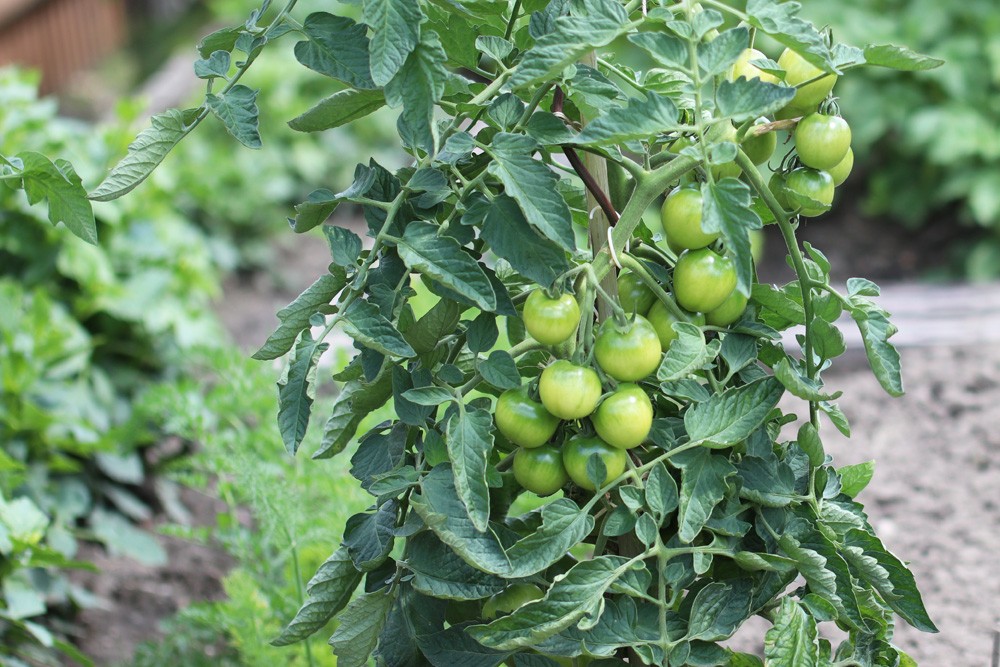Pollination of tomatoes is essential for a high-yield harvest, because only pollinated flowers bear fruit. Learn here how you can support pollination and which method is best for you!
A high-yield harvest is only guaranteed if numerous flowers have been successfully pollinated. In the wild, the wind, bees and bumblebees take care of pollination, so human intervention is not usually necessary. However, if you want to be on the safe side, you can give pollination a helping hand with simple measures.
Contents
Pollination of tomatoes
The majority of tomato varieties are self-fertile, which means that they can pollinate themselves. This is because tomato flowers are hermaphroditic, being equipped with both a stigma and pollen sacs. The pollen sacs contain the pollen, which is released as soon as the stigma is ready for fertilization. This enables the tomatoes to fertilize themselves. However, the pollen sits relatively tightly in the pollen sacs, which is why fertilization is helped along by nature:
- Wind
- Bees
- Bumblebees
Tip: Tomatoes that are not self-pollinated are easy to identify visually because their flower stigma protrudes from the leaves. These tomato varieties require a second tomato plant for pollination.
Optimal conditions

Not only the natural helpers play an essential role in pollination, but also the environmental conditions. Certain conditions must prevail for the pollen to be released and germinate. If the humidity is too high, for example, the pollen clumps together or is not released at all. If, on the other hand, it is too dry, the germination capacity of the pollen is reduced enormously. However, there are also optimal conditions for pollination:
relative humidity: 50-80%
too humid: 80-85%
too dry: 50-80%
temperatures not above 30 degrees
Attract natural helpers
In the garden and on the balcony, pollination is usually taken care of by natural helpers such as bees and bumblebees. However, the home garden does not always offer the optimal incentive to attract these valuable insects. It is therefore advisable to cultivate bumblebee- as well as bee-friendly plants in the garden so that the insects are attracted. The selection of possible plants is enormous, so that every amateur gardener is sure to find a suitable plant or two.
Bumblebees
- Summer lilac
- Bearded flower
- Deadnettle
- Poppy
- Clover
- Clematis
- Mauve
- Basil
- Bellflower
- Clematis
- Lavender
- Wildflowers
- Bee weed
- Bumblebee boxes
The natural helpers can also be settled in the garden by means of bumblebee boxes. This method is particularly environmentally friendly, because a large part of the bumblebee species is now unfortunately highly endangered. The installation of a bumblebee box thus brings several advantages: on the one hand, the tomatoes have helpers for pollination and on the other hand, the protected insects have a nesting aid at their disposal. The bumble bee box is best placed as follows:
- about 4-7 days before flowering
- at a shady location
- under no circumstances direct sun!
- place it close to the ground
Tip: Bumblebees store the exact GPS coordinates of their home, which is why the box should not be moved after colonization. Because even moving a few centimeters confuses the insects so much that they can no longer find their way home.
Pollination by hand
Although the greenhouse provides a protected environment for tomatoes, it also has a disadvantage. Because neither wind nor the natural helpers have direct access to the tomato plants. It is therefore advisable to give pollination in the greenhouse a little help. Even simple actions such as setting up a fan or gently shaking the plant can be promising in this regard. However, it is even better to pollinate the tomatoes specifically from the time the flowers blossom:
Pollination with an electric toothbrush
- is also called “trilling
- Bumblebees are simulated
- Toothbrush is placed just above the blossom
- Pollen is released by vibration
- fall on the stigma
Pollination with brush
- suitable especially for a few tomato plants
- brush with a soft brush over stigmas and pollen sacs
- Pollen collects in the hairs
- therefore always use the same brush
- Do not let the brush get wet!
- Pollen will otherwise stick together or be washed off
Tip: The optimal time for pollination is early in the morning, preferably between 9 and 10 o’clock. This is because too early in the morning the pollen is usually still stuck together and at a later time of day the stigma becomes too dry so that the pollen can no longer adhere.
Varietal propagation
Anyone seeking to propagate through tomato seeds will most likely want to grow a specific variety. However, if several tomato varieties are cultivated side by side, cross-pollination and thus cross-breeding may well occur during pollination. However, varietal purity can be ensured with a few simple steps before the flowers bloom:
- Wrap the plant or individual panicles
- with a close-meshed insect net
- made of tulle or gauze, for example
- However, petals should have sufficient space
- must be able to unfold
- if necessary, break off excess leaves
Tip: Individual flowers can be ideally protected from cross-pollination with a tea filter.


